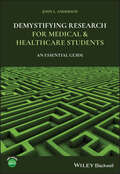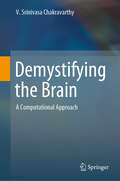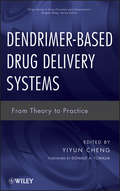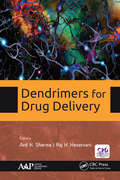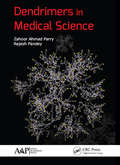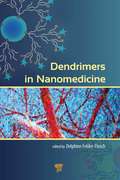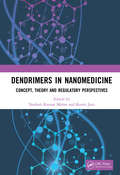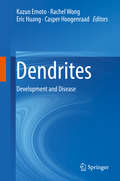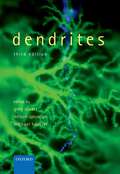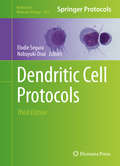- Table View
- List View
Demystifying Psychiatry: A Resource for Patients and Families
by Charles F. Zorumski, MD Eugene Rubin, MD, PhDPsychiatry is arguably the most misunderstood specialty in modern medicine and psychiatrists are often thought of as part physician, part confessor, part police officer, and part shaman. In Demystifying Psychiatry, two eminent psychiatrists offer an illuminating look at the entire field, offering a clear and informative portrait of a medical specialty often clouded in myth. Zorumski and Rubin range from a basic discussion of what psychiatry is, to the types of illnesses psychiatrists treat, the training of psychiatrists, the treatment of psychiatric disorders (covering medications, psychotherapy, lifestyle interventions, electroconvulsive therapy, and much more), and how families can help with treatment. They caution the consumer about practices that should raise red flags. The book also covers new trends in psychiatry and explores the future of the field, predicting that major advances in genetics and neuroscience will lead to rapid and amazing changes in psychiatry. The book concludes with extensive reference materials that will be valuable both to general readers and medical practitioners.
Demystifying Research for Medical and Healthcare Students: An Essential Guide
by John L. AndersonDEMYSTIFYING RESEARCH FOR MEDICAL & HEALTHCARE STUDENTS All healthcare students need to understand research methods to be able to understand research articles and to actively engage in research where necessary. Most clinical programs include research training within their courses, and many students are required to undertake an assessed research project—both at undergraduate and postgraduate levels. Breaking down the jargon barriers of research methods, and designed for those new to the world of research, Demystifying Research is a straightforward and highly accessible guide to fundamental research methods, approaches, and skills. This student-friendly resource describes quantitative and qualitative research approaches, mixed research methods, research ethics and governance, research skills and more. Step-by-step, students learn to appraise research in scholarly articles, design a project, and conduct research in the lab, in clinical practice, and other real-life situations. Technical jargon and classic research are explained in plain English, while relevant theory is illustrated through relatable examples of research in practice. Designed to make learning about research easy, this valuable guide: Explains basic research methods in a direct and engaging style Breaks research methods down into manageable, easy-to-digest pieces Defines what research is, and provides an overview of its methods and methodologies Covers all key areas of research, including observational and experimental approaches, and clinical trials Includes real-life examples of successful student research projects Features a companion website containing lecture slides available to download in PowerPoint Demystifying Research is a must-have for undergraduate and postgraduate medical, nursing, other healthcare and social sciences students, as well as professionals looking to refresh their knowledge.
Demystifying Research for Medical and Healthcare Students: An Essential Guide
by John L. AndersonDEMYSTIFYING RESEARCH FOR MEDICAL & HEALTHCARE STUDENTS All healthcare students need to understand research methods to be able to understand research articles and to actively engage in research where necessary. Most clinical programs include research training within their courses, and many students are required to undertake an assessed research project—both at undergraduate and postgraduate levels. Breaking down the jargon barriers of research methods, and designed for those new to the world of research, Demystifying Research is a straightforward and highly accessible guide to fundamental research methods, approaches, and skills. This student-friendly resource describes quantitative and qualitative research approaches, mixed research methods, research ethics and governance, research skills and more. Step-by-step, students learn to appraise research in scholarly articles, design a project, and conduct research in the lab, in clinical practice, and other real-life situations. Technical jargon and classic research are explained in plain English, while relevant theory is illustrated through relatable examples of research in practice. Designed to make learning about research easy, this valuable guide: Explains basic research methods in a direct and engaging style Breaks research methods down into manageable, easy-to-digest pieces Defines what research is, and provides an overview of its methods and methodologies Covers all key areas of research, including observational and experimental approaches, and clinical trials Includes real-life examples of successful student research projects Features a companion website containing lecture slides available to download in PowerPoint Demystifying Research is a must-have for undergraduate and postgraduate medical, nursing, other healthcare and social sciences students, as well as professionals looking to refresh their knowledge.
Demystifying the Brain: A Computational Approach
by V. Srinivasa ChakravarthyThis book presents an emerging new vision of the brain, which is essentially expressed in computational terms, for non-experts. As such, it presents the fundamental concepts of neuroscience in simple language, without overwhelming non-biologists with excessive biological jargon. In addition, the book presents a novel computational perspective on the brain for biologists, without resorting to complex mathematical equations.It addresses a comprehensive range of topics, starting with the history of neuroscience, the function of the individual neuron, the various kinds of neural network models that can explain diverse neural phenomena, sensory-motor function, language, emotions, and concluding with the latest theories on consciousness. The book offers readers a panoramic introduction to the “new brain” and a valuable resource for interdisciplinary researchers looking to gatecrash the world of neuroscience.
Demystifying the Law: An Introduction for Professionals
by Daniel A. BronsteinDemystifying the Law: An Introduction for Professionals explains unfamiliar legal concepts in interesting contexts, thus helping you to understand and remember them. It illustrates legal principles using simple examples that anyone can understand. No single book can turn you into a lawyer, but this one can help you decide when you need a lawyer's assistance and help you ask intelligent questions of your lawyer. It can even help keep you out of situations requiring a lawyer. Part I tells you where our laws come from and how they are applied in the court system. Part II explains the role in law of the executive branch of government, including quasi-legislative and quasi-judicial activities, judicial review, and technicalities and terms. Part III covers several specific legal issues, including civil procedure, criminal law concepts, burden of proof, the "reasonable person" concept, breach of duty, personal and product liability, and malpractice. It also gives brief introductions to contracts, insurance law, workers' compensation, property law, environmental law, water law, and other legal matters. Every professional should own this valuable resource! Ideal for both personal and business use. Appendices include how to find legal citations and extracts from the federal rules of civil procedure.
Demystifying the Law: An Introduction for Professionals
by Daniel A. BronsteinDemystifying the Law: An Introduction for Professionals explains unfamiliar legal concepts in interesting contexts, thus helping you to understand and remember them. It illustrates legal principles using simple examples that anyone can understand. No single book can turn you into a lawyer, but this one can help you decide when you need a lawyer's assistance and help you ask intelligent questions of your lawyer. It can even help keep you out of situations requiring a lawyer. Part I tells you where our laws come from and how they are applied in the court system. Part II explains the role in law of the executive branch of government, including quasi-legislative and quasi-judicial activities, judicial review, and technicalities and terms. Part III covers several specific legal issues, including civil procedure, criminal law concepts, burden of proof, the "reasonable person" concept, breach of duty, personal and product liability, and malpractice. It also gives brief introductions to contracts, insurance law, workers' compensation, property law, environmental law, water law, and other legal matters. Every professional should own this valuable resource! Ideal for both personal and business use. Appendices include how to find legal citations and extracts from the federal rules of civil procedure.
An Den Grenzen der Psychiatrie
by Oswald BumkeDieser Buchtitel ist Teil des Digitalisierungsprojekts Springer Book Archives mit Publikationen, die seit den Anfängen des Verlags von 1842 erschienen sind. Der Verlag stellt mit diesem Archiv Quellen für die historische wie auch die disziplingeschichtliche Forschung zur Verfügung, die jeweils im historischen Kontext betrachtet werden müssen. Dieser Titel erschien in der Zeit vor 1945 und wird daher in seiner zeittypischen politisch-ideologischen Ausrichtung vom Verlag nicht beworben.
Dendrimer-Based Drug Delivery Systems: From Theory to Practice (Wiley Series in Drug Discovery and Development #18)
by Yiyun ChengThe opportunities and challenges of using dendrimers to improve drug delivery Among pharmaceutical and biomedical researchers, the use of dendrimers in drug delivery systems has attracted increasing interest. In particular, researchers have noted that the volume of a dendrimer increases when it has a positive charge. If this property can be applied effectively, dendrimers have enormous potential in drug delivery systems, directly supplying medication to targeted human organs. With contributions from an international team of pioneers and experts in dendrimer research, this book provides a comprehensive overview of the latest research efforts in designing and optimizing dendrimer-based drug delivery systems. The book analyzes key issues, demonstrating the critical connections that link fundamental concepts, design, synthesis, analytical methodology, and biological assessment to the practical use of dendrimers in drug delivery applications. Topics covered include: Dendrimer history Synthesis Physicochemical properties Principles of drug delivery Applications in diverse biomedical fields Dendrimer-Based Drug Delivery Systems reflects the authors' thorough review and analysis of the current literature as well as their own firsthand experience in the lab. Readers will not only discover the current state of the science, but also gain valuable insights into fruitful directions for future research. References at the end of each chapter serve as a gateway to the growing body of literature in the field, enabling readers to explore each individual topic in greater depth. Pharmaceutical and biomedical researchers will find this book a unique and essential guide to the opportunities, issues, and challenges involved in fully exploiting the potential of dendrimers to improve drug delivery.
Dendrimer-Based Drug Delivery Systems: From Theory to Practice (Wiley Series in Drug Discovery and Development #18)
by Yiyun Cheng Donald A. TomaliaThe opportunities and challenges of using dendrimers to improve drug delivery Among pharmaceutical and biomedical researchers, the use of dendrimers in drug delivery systems has attracted increasing interest. In particular, researchers have noted that the volume of a dendrimer increases when it has a positive charge. If this property can be applied effectively, dendrimers have enormous potential in drug delivery systems, directly supplying medication to targeted human organs. With contributions from an international team of pioneers and experts in dendrimer research, this book provides a comprehensive overview of the latest research efforts in designing and optimizing dendrimer-based drug delivery systems. The book analyzes key issues, demonstrating the critical connections that link fundamental concepts, design, synthesis, analytical methodology, and biological assessment to the practical use of dendrimers in drug delivery applications. Topics covered include: Dendrimer history Synthesis Physicochemical properties Principles of drug delivery Applications in diverse biomedical fields Dendrimer-Based Drug Delivery Systems reflects the authors' thorough review and analysis of the current literature as well as their own firsthand experience in the lab. Readers will not only discover the current state of the science, but also gain valuable insights into fruitful directions for future research. References at the end of each chapter serve as a gateway to the growing body of literature in the field, enabling readers to explore each individual topic in greater depth. Pharmaceutical and biomedical researchers will find this book a unique and essential guide to the opportunities, issues, and challenges involved in fully exploiting the potential of dendrimers to improve drug delivery.
Dendrimers for Drug Delivery
by Anil K. Sharma Raj K. KeservaniWith chapters from highly skilled, experienced, and renowned scientists and researchers from around the globe, Dendrimers for Drug Delivery provides an abundance of information on dendrimers and their applications in the field of drug delivery. The volume begins with an introduction to dendrimers, summarizing dendrimer applications and the striking features of dendrimers. It goes on to present the details of usual properties, structure, classification, and methods of synthesis, with relevant examples. The toxicity of dendrimers is also discussed. The chapter authors provide an exhaustive amount of information about dendrimers and their biomedical applications, including biocompatibility and toxicity aspects, a very useful feature. This informative volume will be valuable resource that will help readers to create products derived from dendrimers and navigate through the regulatory, manufacturing, and quality control hurdles. It will be an important resource for researchers, scientists, upper-level students, and industry professionals.
Dendrimers for Drug Delivery
by Anil K. Sharma Raj K. KeservaniWith chapters from highly skilled, experienced, and renowned scientists and researchers from around the globe, Dendrimers for Drug Delivery provides an abundance of information on dendrimers and their applications in the field of drug delivery. The volume begins with an introduction to dendrimers, summarizing dendrimer applications and the striking features of dendrimers. It goes on to present the details of usual properties, structure, classification, and methods of synthesis, with relevant examples. The toxicity of dendrimers is also discussed. The chapter authors provide an exhaustive amount of information about dendrimers and their biomedical applications, including biocompatibility and toxicity aspects, a very useful feature. This informative volume will be valuable resource that will help readers to create products derived from dendrimers and navigate through the regulatory, manufacturing, and quality control hurdles. It will be an important resource for researchers, scientists, upper-level students, and industry professionals.
Dendrimers in Medical Science
by Zahoor Ahmad Parry Rajesh PandeyThis valuable new book offers a new perspective on dendrimers that bridges the gap between basic research and applied nanomedicine. It explores the ultimate effectiveness of dendrimers in theranostics, a promising field that combines therapeutics and diagnostics into single multifunctional formulations used to affect therapy or treatment of a disease state. The authors examine the potential uses of dendrimers, which have proven their capabilities in local/systemic drug delivery, physical stabilization of the drug, solubility enhancement of the poorly soluble drugs, and gene delivery.
Dendrimers in Medical Science
by Zahoor Ahmad Parry Rajesh PandeyThis valuable new book offers a new perspective on dendrimers that bridges the gap between basic research and applied nanomedicine. It explores the ultimate effectiveness of dendrimers in theranostics, a promising field that combines therapeutics and diagnostics into single multifunctional formulations used to affect therapy or treatment of a disease state. The authors examine the potential uses of dendrimers, which have proven their capabilities in local/systemic drug delivery, physical stabilization of the drug, solubility enhancement of the poorly soluble drugs, and gene delivery.
Dendrimers in Nanomedicine
by Delphine Felder-FleschNanomedicine can take advantage of the recent developments in nanobiotechnology research for the creation of platforms with superior drug carrier capabilities, selective responsiveness to the environment, unique contrast enhancement profiles, and improved accumulation at the disease site. This book provides a broad glimpse of how various dendritic nanomaterials have been designed and used as efficient tools for nanomedicine. It comprises a pedagogic introduction to dendrimers and hyperbranched systems and their classical and accelerated syntheses through cutting-edge methodologies. The chapters on dendronized magnetic nanoparticles as theranostics, dendrimers in theory (molecular simulations), siRNA delivery with dendrimers, and dendrimers for image-guided therapy, combined with chapters focused on specific types of dendrimers or hyperbranched structures, detail the cutting-edge research in nanomedicine. Finally, a detailed chapter on issues related to the pharmacokinetics and biodistribution of dendrimers helps choose the right structures for successful transfer from bench to bedside. This book will appeal to those involved in nanobiotechnology, macromolecular science, cancer therapy, tissue repair, and siRNA delivery research.
Dendrimers in Nanomedicine
by Delphine Felder-FleschNanomedicine can take advantage of the recent developments in nanobiotechnology research for the creation of platforms with superior drug carrier capabilities, selective responsiveness to the environment, unique contrast enhancement profiles, and improved accumulation at the disease site. This book provides a broad glimpse of how various dendritic nanomaterials have been designed and used as efficient tools for nanomedicine. It comprises a pedagogic introduction to dendrimers and hyperbranched systems and their classical and accelerated syntheses through cutting-edge methodologies. The chapters on dendronized magnetic nanoparticles as theranostics, dendrimers in theory (molecular simulations), siRNA delivery with dendrimers, and dendrimers for image-guided therapy, combined with chapters focused on specific types of dendrimers or hyperbranched structures, detail the cutting-edge research in nanomedicine. Finally, a detailed chapter on issues related to the pharmacokinetics and biodistribution of dendrimers helps choose the right structures for successful transfer from bench to bedside. This book will appeal to those involved in nanobiotechnology, macromolecular science, cancer therapy, tissue repair, and siRNA delivery research.
Dendrimers in Nanomedicine: Concept, Theory and Regulatory Perspectives
by Neelesh Kumar Mehra Keerti JainDendrimers, hyperbranched macromolecules, emerged just few decades ago but show promising potential as drug delivery nanocarriers, theranostic agents and gene vectors; in the pharmaceutical research and innovation area as well as in other healthcare applications. Although tremendous advancements have been made in dendrimer chemistry and their applications since their emergence, the synthesis, development and design of pure and safe dendrimer-based products have been a major challenge in this area. This book, edited by well-known researchers in the area of nanomaterials and drug-based drug delivery applications, exhaustively covers the nanotechnological aspects, concepts, properties, characterisation, application, biofate and regulatory aspects of dendrimers. It includes sixteen vivid chapters by renowned formulators, researchers and academicians from all over the world, highlighting their specialised areas of interest in the fields of chemistry, biology, pharmacy and nanomedicine. Features: • Highlights dendrimers’ advancements in nanomedicine in the development of safe healthcare and biotechnological products • Covers physicochemical aspects, biofate, drug delivery aspects and gene therapy using dendrimers • Covers biomedical application of dendrimers in the field of biological sciences • Gives examples of dendrimer–guest interaction chemistry Dendrimers in Nanomedicine: Concept, Theory and Regulatory Perspectives provides the comprehensive overview of the latest research efforts in designing, optimising, development and scale-up of dendrimer-mediated delivery systems. It analyses the key challenges of synthesis, design, molecular modelling, fundamental concepts, drug delivery aspects, analytical tools and biological fate as well as regulatory consideration to the practical use of dendrimer application. Dr. Neelesh Kumar Mehra Assistant Professor of Pharmaceutics in the Department of Pharmaceutics at the National Institute of Pharmaceutical Education & Research (NIPER), Hyderabad, India. He has authored more than sixty peer-reviewed publications in highly reputed international journals, as well as book chapters and contributions on two patents. Dr. Mehra has 11 years of rich research and teaching experience in the formulation and development of complex, innovative biopharmaceutical products including micro- and nanotechnologies for regulated markets. Dr. Keerti Jain Assistant Professor of Pharmaceutics in the Department of Pharmaceutics, NIPER, Raebareli, India. For more than 10 years, she has been actively engaged in formulation and development of nanomedicines. Dr. Jain has supervised masters and doctoral pharmaceutics students in their research works which have been published in high quality, good impact factor journals. She has also authored more than 60 international manuscripts in peer reviewed high impact journals. In 2019, she was awarded the prestigious ICMR-Amir Shakuntala Award.
Dendrimers in Nanomedicine: Concept, Theory and Regulatory Perspectives
by Neelesh Kumar Mehra Keerti JainDendrimers, hyperbranched macromolecules, emerged just few decades ago but show promising potential as drug delivery nanocarriers, theranostic agents and gene vectors; in the pharmaceutical research and innovation area as well as in other healthcare applications. Although tremendous advancements have been made in dendrimer chemistry and their applications since their emergence, the synthesis, development and design of pure and safe dendrimer-based products have been a major challenge in this area. This book, edited by well-known researchers in the area of nanomaterials and drug-based drug delivery applications, exhaustively covers the nanotechnological aspects, concepts, properties, characterisation, application, biofate and regulatory aspects of dendrimers. It includes sixteen vivid chapters by renowned formulators, researchers and academicians from all over the world, highlighting their specialised areas of interest in the fields of chemistry, biology, pharmacy and nanomedicine. Features: • Highlights dendrimers’ advancements in nanomedicine in the development of safe healthcare and biotechnological products • Covers physicochemical aspects, biofate, drug delivery aspects and gene therapy using dendrimers • Covers biomedical application of dendrimers in the field of biological sciences • Gives examples of dendrimer–guest interaction chemistry Dendrimers in Nanomedicine: Concept, Theory and Regulatory Perspectives provides the comprehensive overview of the latest research efforts in designing, optimising, development and scale-up of dendrimer-mediated delivery systems. It analyses the key challenges of synthesis, design, molecular modelling, fundamental concepts, drug delivery aspects, analytical tools and biological fate as well as regulatory consideration to the practical use of dendrimer application. Dr. Neelesh Kumar Mehra Assistant Professor of Pharmaceutics in the Department of Pharmaceutics at the National Institute of Pharmaceutical Education & Research (NIPER), Hyderabad, India. He has authored more than sixty peer-reviewed publications in highly reputed international journals, as well as book chapters and contributions on two patents. Dr. Mehra has 11 years of rich research and teaching experience in the formulation and development of complex, innovative biopharmaceutical products including micro- and nanotechnologies for regulated markets. Dr. Keerti Jain Assistant Professor of Pharmaceutics in the Department of Pharmaceutics, NIPER, Raebareli, India. For more than 10 years, she has been actively engaged in formulation and development of nanomedicines. Dr. Jain has supervised masters and doctoral pharmaceutics students in their research works which have been published in high quality, good impact factor journals. She has also authored more than 60 international manuscripts in peer reviewed high impact journals. In 2019, she was awarded the prestigious ICMR-Amir Shakuntala Award.
Dendrites: Development and Disease
by Kazuo Emoto Rachel Wong Eric Huang Casper HoogenraadStudies in human patients and animal models of disease suggest a strong correlation between defects in dendrite development and common neurological disorders such as autism. Much of this book is thus dedicated toward highlighting recent advances in our understanding of the cellular and molecular mechanisms that regulate the development and maintenance of dendrites, a crucial component of neurons. The book begins by presenting the current state of knowledge on the building blocks or cell biology of dendrites. Mechanisms that sculpt the stereotypic architecture of dendritic arbors and shape their connectivity are also discussed, along with recent work describing how dendritic organization and connectivity are perturbed in disease. A unique aspect of the book is its exploration of diverse neuronal cell types across vertebrates and invertebrates, allowing a comparison of mechanisms across distinct circuits and species. The book comprises six parts, which cover the major advances in the field: Part 1, Introduction; Part 2, Basic Biology of Dendrites; Part 3, Patterning Dendritic Architecture of Neurons and Their Populations; Part 4, Cellular and Molecular Control of Dendrite Development and Maintenance; Part 5, Synapse Formation onto Dendrites; and Part 6, Dendrites in Disease. The book offers an excellent point of entry for students interested in neuroscience, as well as for clinicians.
Dendrites
by Greg Stuart, Nelson Spruston and Michael HäusserDendrites are complex neuronal structures that receive and integrate synaptic input from other nerve cells. They therefore play a critical role in brain function. Although dendrites were discovered over a century ago, due to the development of powerful new techniques there has been a dramatic resurgence of interest in the properties and function of these beautiful structures. This is the third edition of the first book devoted exclusively to dendrites. It contains a comprehensive survey of the current state of dendritic research across a wide range of topics, from dendritic morphology, evolution, development, and plasticity through to the electrical, biochemical and computational properties of dendrites, and finally to the key role of dendrites in brain disease. The third edition has been thoroughly revised, with the addition of a number of new chapters and comprehensive updates or rewrites of existing chapters by leading experts. "Dendrites" will be of interest to researchers and students in neuroscience and related fields, as well as to anyone interested in how the brain works.
Dendrites
Dendrites are complex neuronal structures that receive and integrate synaptic input from other nerve cells. They therefore play a critical role in brain function. Although dendrites were discovered over a century ago, due to the development of powerful new techniques there has been a dramatic resurgence of interest in the properties and function of these beautiful structures. This is the third edition of the first book devoted exclusively to dendrites. It contains a comprehensive survey of the current state of dendritic research across a wide range of topics, from dendritic morphology, evolution, development, and plasticity through to the electrical, biochemical and computational properties of dendrites, and finally to the key role of dendrites in brain disease. The third edition has been thoroughly revised, with the addition of a number of new chapters and comprehensive updates or rewrites of existing chapters by leading experts. "Dendrites" will be of interest to researchers and students in neuroscience and related fields, as well as to anyone interested in how the brain works.
Dendritic Cell Protocols (Methods in Molecular Biology #1423)
by Elodie Segura and Nobuyuki OnaiThe third edition of this volume is aimed at providing both beginners and more experienced researchers a choice of methods to isolate and analyze dendritic cells(DC). An introductory review provides an overview of recent advances in the characterization of DC subsets in mouse and human. While additional chapters provide methods to culture human and mouse dendritic cells, protocols for the isolation of dendritic cells, the isolation of dendritic cell progenitors from mouse, and the purification of dendritic cells from human blood. Written in the highly successful Methods in Molecular Biology series format, chapters include introductions to their respective topics, lists of the necessary materials and reagents, step-by-step, readily reproducible laboratory protocols, and tips on troubleshooting and avoiding known pitfalls. Authoritative and cutting-edge, Dendritic Cell Protocols, Third Edition aims to ensure successful results in the further study of this vital field.
Dendritic Cell Protocols (Methods in Molecular Biology #595)
by Shalin H. NaikGiven the vital importance of immune system research, the gathering of clear, consistent, and informative protocols involving the study of dendritic cells is paramount. Bringing the popular first edition fully up to date, Dendritic Cell Protocols, Second Edition presents protocols from experts in the field that cover the basics and more complex forays into the exploration of DC development and function, both in mice and humans. The first section of the volume involving humans explores topics such as the isolation of blood DC subtypes, primary skin Langerhans cells, and the generation of gene-manipulated human DCs with the inclusion of more clinically relevant methods as well, while the second section involving rodent models delves into DC and precursor generation in vitro, isolation ex vivo, disease models, as well as DC functions and properties. Written in the highly successful Methods in Molecular Biology™ series style, chapters include introductions to their respective subjects, lists of the necessary materials and reagents, step-by-step, readily reproducible laboratory protocols, and notes on troubleshooting and avoiding known pitfalls. Comprehensive and cutting-edge, Dendritic Cell Protocols, Second Edition aims to become a bench-side handbook for both beginners and experts in the field of DC research and a long-term reference for some of the most popular methods put forward by those who lead the field.
Dendritic Cell Protocols (Methods in Molecular Medicine #64)
by Stephen P. Robinson, Andrew J. Stagg and Stella C. KnightDendritic Cell Protocols provides chapter and verse for many useful practical approaches to the art of studying dendritic cells. The book gives information on the usual techniques for derivation of human dendritic cells from precursor stem cells, such as monocytes. In addition it provides data on the difficult tasks of isolating dendritic cells directly from different tissues; whether dendritic cells from precursor cells or from tissues of mouse or human are required, this book contributes practical information. The last section of the book is devoted to functional aspects of dendritic cells ranging from inf- mation relevant to cell migration to antigen uptake and T cell stimulation. But what is a dendritic cell? The explosion of studies on this cell type over the last few years is breathtaking. We now have so-called “myeloid” and “plas- cytoid” dendritic cells; are they of separate lineages or are they related? There are claims that dendritic cells can be derived from B cells and from granulocytes, as well as from “monocytes. ” Lymphocytes can be switched on or off by dendritic cells. Dendritic cells can preferentially cause Th1 or Th2 responses or some may stimulate B cells directly. When there is so much scope for exploring these new developments, it is particularly important that the data that are established and the practical basis for this work are clearly available, a task that this book fulfils.
Dendritic Cells (Handbook of Experimental Pharmacology #188)
by Giovanna Lombardi Yanira Riffo-VasquezThe understanding of the role of dendritic cells (DCs) in immune responses has come a long way since Steinmann and colleagues described these cells in 1972. - tensive research during the intervening period has provided a good understanding of the complexity of the DC system and its pivotal role in immunity. It is also now clearer how different subsets of DCs interact and regulate each other and how DC populations affect the function of other cells of the immune system. The improved understanding of their role in immune response has led to the idea that modulation of DC functions by, for example, pharmacological agents could be used as a pot- tial therapeutic approach in some pathological conditions. The actual applicability and therapeutic potential of all these approaches is yet to be fully demonstrated but nonetheless, animal models of human diseases are proving to be very helpful in the evaluation of manipulated DCs as a new treatment in diseases like cancer, auto- munity or asthma. DCs are integral to the initiation and regulation of immune response (Banchereau et al. 2000). The outcome of antigen presentation by DCs is determined by their maturation status, which can be induced by their interaction with danger signals. To recognise a wide array of pathogen-associated molecular patterns (PAMP), DCs express a number of pattern recognition receptors (PRR) such as Toll-like rec- tors (TLRs) and C-type lectin receptors (CLR) that recognise structural components of pathogens and discriminate between self and non-self molecules.
Dendritic Cells: Biology and Clinical Applications
by Michael T. Lotze Angus W. ThomsonDendritic Cells, Second Edition is the new edition of the extremely successful book published in 1998. With the volume of literature on dendritic cells doubling every year, it is almost impossible to keep up. This book provides the most up-to-date synthesis of the literature, written by the very best authors. It is essential reading for any scientist working in immunology, cell biology, infectious diseases, cancer, transplantation, genetic engineering, or the pharmaceutical/biotechnology industry.An entirely new section on DC biology is included in this edition. Also new to this edition are chapters on: ImagingInteraction of dendritic cells with virusesDendritic cells and dendrikines, chemokines and the endotheliumMolecules expressed in dendritic cellsRole of dendritic cells in wound healing and atherosclerosisDelivery of apoptotic bodiesGenetic engineering of dendritic cellsImagingPractical aspects of clinical protocol development

